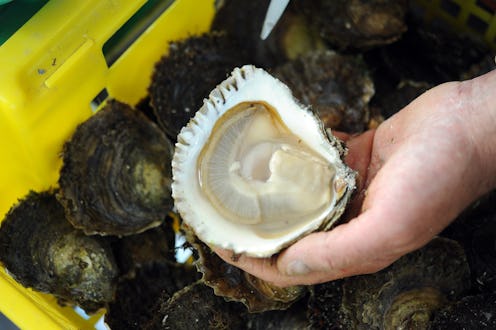News
You And Oysters Can Save The World
America's rivers and coasts are heavily polluted from industrial emissions and agricultural runoff. But now, there's a surprising solution: oysters. Yes, those delicious shellfish you enjoy slurping down at happy hour can actually help purify water. Keeping natural waterways clean is important not only for preserving their ecosystems and the environment as a whole, but also for ensuring that people have healthy surroundings. These small creatures are pretty incredible, and there are a few ways you can help oysters clean up rivers and oceans.
A single oyster filters between 30 and 50 gallons of water each day by pumping water through its gills to eat. This process removes harmful nutrient pollutants like nitrogen, phosphorus, and carbon dioxide, improves water clarity, controls algae, and attracts other sea life. Oysters are keystone species, meaning other species largely depend on them, so their presence in an ecosystem is crucial for biodiversity within an estuary or coastline.
Clean water is important for everyone, whether you live near the coast or not. According to the EPA, 55 percent of U.S. waterways are polluted and in poor condition, which threatens Americans' drinkable supply and is unhealthy for anyone swimming in or eating fish from these bodies. Oyster reefs also protect coastal cities from erosion and high waves during tropical storms, as the creatures' hard shells stabilize the shore. These little shellfish actually help keep us safe in times of serious natural disasters.
Increased ocean acidity (largely due to the use of fossil fuels), disease, and over-harvesting have drastically decreased oyster populations. About 85 percent of oyster reefs have disappeared around the world in the last century. Restoring these reefs would help rebuild entire marine ecosystems, and create a much cleaner and safer environment for all of us.
Here's how you can help restore oyster reefs, and in turn clean the nation's water:
Support Local Oyster Projects
Cities along the U.S. coasts have started oyster restoration projects to increase the population and clean up local waters, and most need volunteers to build viable habitats for the oysters and check on their health. New York's Billion Oyster Project, Massachusetts Oyster Project, the Chesapeake Bay Foundation, the Nature Conservancy, South Carolina Oyster Restoration and Enhancement, and Washington's Puget Sound Restoration Fund are all dedicated to the cause.
As with any nonprofit or environmental program, donations help these organizations continue their work. Whether you live nearby but don't have enough time to volunteer or you live in Middle America, giving money is a simple way to support the oysters.
Stop Eating Wild Oysters
Before you panic, know that you don't need to stop eating oysters entirely. In fact, eating oysters raised in local aquaculture farms supports local farmers as well as the industry that helps clean our waters. Shellfish farms are one of the most sustainable forms of fish production, so environmentalists can feel secure in giving them their business. The trouble with eating oysters comes from slurping down wild specimens, which have been over-harvested and are struggling to survive. "There are not that many places left where wild oysters are sustainably harvested," Mike Beck, lead marine scientist with the Nature Conservancy, told Grist.
There are even ways you can support your local restoration project while also enjoying some tasty oysters, as some environmental groups sell shellfish from their farms. The Puget Sound Restoration Fund, for instance, has two community shellfish farms that sell oysters at a local stand, and which also use a community-supported aquaculture (CSA) model in which people sign up for a membership and have shellfish delivered to their home throughout the season. This kills two birds with one stone — you're ensuring that the oysters you eat are sustainably farmed and supporting your local water improvement project.
Recycle Shells
If your cooking capabilities are savvy enough to prepare oysters at home, a simple way to make an impact is to recycle the shells after your feast. The same way other food scraps can be composted, empty oyster shells can be used in restoration projects, as they provide a surface for young oysters to settle on and grow. After they've formed a hard reef, oysters provide shelter for other marine animals and protect shorelines against erosion. Many restoration projects, including the Massachusetts Oyster Project and the South Carolina Oyster Restoration and Enhancement, accept donated shells.
You can also talk to local oyster bars and restaurants and encourage them to recycle their shells. Restaurants go through a lot more shells than a single person (unless you're eating oysters at home every night), so their donations are very beneficial for restoration projects with a shortage of shells.
Start Your Own Project
For very motivated oyster enthusiasts, starting a restoration project in an area without one is the most direct way to help increase America's oyster population and clean up a local waterway. This would be a big commitment, but if you're passionate about saving the environment, protecting disappearing species, and cleaning up dirty water, then such a project may be the perfect hobby for you.
Images: Chesapeake Bay Foundation/YouTube (1)
